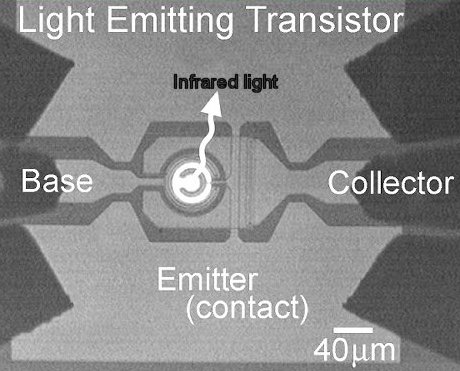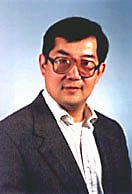Transistors and light-emitting diodes (LEDs) have become two of the most well-known and useful devices, essential to everything from mp3 players to the future of low-wattage lighting. Now, a hybrid device – a light-emitting transistor (LET) – has been invented by Nick Holonyak Jr and Milton Feng of the University of Illinois at Urbana-Champaign. This device could become the fundamental element in optoelectronics devices for faster telecommunications and many other applications.
We have demonstrated light emission from the base layer of a heterojunction bipolar transistor, and showed that the light intensity can be controlled by varying the base current, explains Holonyak, who is the John Bardeen Professor of Electrical and Computer Engineering and Physics at Illinois. Holonyak was the inventor of the first practical light-emitting diode (LED) and the first semiconductor laser to operate in the visible spectrum.

The transistor
This work is still in the early stage, so it is not yet possible to say what all the applications will be, he adds. But a light-emitting transistor opens up a rich domain of integrated circuitry and high-speed signal processing that involves both electrical signals and optical signals.
Transistors usually have two ports: one is for an input, the other for an output. The light-emitting transistor, on the other hand, has three ports: an input, an electrical output, and an optical output. This means that we can interconnect optical and electrical signals for display or communication purposes, notes Feng, who is ironically Holonyak Professor of Electrical and Computer Engineering at Illinois and creator of the world’s fastest bipolar transistor, a device that operates at a frequency of 509 gigahertz.

Nick Holonyak Jr
Graduate student Walid Hafez fabricated the light-emitting transistor in the university’s Micro and Nanotechnology Laboratory. Where traditional transistors utilise crystals of silicon and germanium, Hafez instead used indium gallium phosphide and gallium arsenide to build the light-emitting transistor. In a bipolar device, there are two kinds of injected carriers: negatively charged electrons and positively charged holes, Holonyak explains. Some of these carriers will recombine rapidly, supported by a base current that is essential for the normal transistor function.

Milton Feng
By using these alternative semiconductor materials, the researchers were able to control the recombination process in indium gallium phosphide and gallium arsenide materials so that infrared photons are produced. In the past, this base current has been regarded as a waste current that generates unwanted heat, Holonyak adds. We’ve shown that for a certain type of transistor, the base current creates light that can be modulated at transistor speed.

Walid Hafez
This recombination process is almost the same as that exploited in LEDs to produce visible, rather than infrared, light; however, there is an important difference. In a conventional LED, the photons are produced much more rapidly. The Illinois transistor produces infrared in phase with the transistor’s base current, so it can be modulated – or switched on and off – at an operating frequency of 1 megahertz and perhaps much faster, which is a switching speed impossible to attain with an LED but perfectly suited to high-speed optical circuitry of the kind used to transmit data across fibre optic networks as well as in other applications.
At such speeds, optical interconnects could replace electrical wiring between electronic components on a circuit board, Feng explains. This work could be the beginning of an era in which photons are directed around a chip in much the same way as electrons are manoeuvred on conventional silicon chips, but at the speed of light! In retrospect, we could say the groundwork for this was laid more than 56 years ago with John Bardeen and Walter Brattain and their first germanium transistor, adds Holonyak, who was Bardeen’s first graduate student. But the direct recombination involving a photon is weak in germanium materials, and John and Walter just wouldn’t have seen the light – even if they had looked. If John were alive and we showed him this device, he would have to have a big grin.
Further reading
Appl. Phys. Lett., 2004, 84(1), 151-153
http://dx.doi.org/10.1063/1.1637950
Nick Holonyak Jr
http://www.ece.illinois.edu/people/profile.asp?nholonya
Milton Feng
http://www.ece.illinois.edu/people/profile.asp?mfeng
Suggested searches
transistors
light emitting diodes